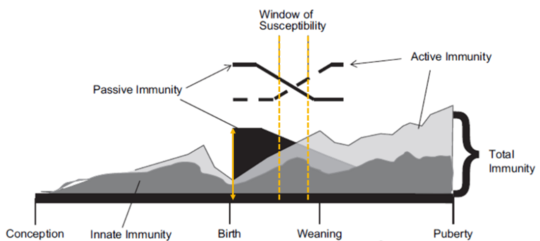Scours in calves: Improving resilience from the start - Part 2
After giving you first insights into scours in calves, a current and feared challenge in cattle farming, we now would like to have a look at the causes of this disease and see how to improve resilience in calves – of course with the use of our precious substances from nature.
Why is diarrhea occurring?

Because of the absence of immunity transfer in utero, calves rely on the agents in the colostrum, such as immunoglobulins (Ig), to acquire protection against pathogens before they can produce their own immune defenses to a high enough level. Depending on the initial amount of Ig transferred via the colostrum, calves are more or less susceptible to diseases. After a few weeks, there is a transition from passive/colostrum to active/own immunity, as the level of Ig in the colostrum fades over time (Figure 2).
This transition period is considered a window of increased susceptibility since the total immunity is not high enough to prevent diseases. Together with the birth period, this is the time when diarrhea is most often observed in calves.
The outbreak of a disease is the result of a combination of different factors:
- The presence of pathogens in a high enough concentration in the calf’s immediate environment, related to the hygiene and housing management
- The contamination of the calf by the pathogen: by contact with other animals, soiled feed/water, walls, or fences
- The infection of the calf by the pathogen: the calf’s immune system is not “strong” enough to defend itself
To prevent the occurrence of diarrhea, some measures can be implemented to control the pathogenic pressure and strengthen the calf’s resilience.
Preventing diarrhea
Pathogenic infection can occur as early as birth; using a clean calving pen and clean material, disinfecting the newborn’s navel, and moving the calf quickly to an individual pen are complementary measures to reduce the pathogenic pressure. Providing fresh straw bedding in sufficient amounts will make the calf comfortable and reduce contact with the ground and potential pathogens.
The second leverage to reduce the incidence of diarrhea is to strengthen the calf’s immunity by colostrum management. To ensure a successful transfer of passive immunity (TPI) to the calf, it is essential to:
- assess the quality of the colostrum provided: the IgG content should be higher than 50g/L
- feed the colostrum as soon as possible and in sufficient quantity: the calf should get 200-300g of IgG in 2L feedings within 12h after birth
- check the calf’s blood serum IgG between 24 and 48h of life: it should be over 10g/L
A successful TPI is related to the more remarkable survival of the calf but also to a reduced risk of catching a disease. Various studies also suggest a greater severity of diseases in calves with lower PI levels.
Small but with a big impact
On top of these management measures, the use of well formulated phytogenic feed additives (PFA) has been proven to be an efficient stimulator of the calf’s resilience. Phytogenics are standardized, specific and science-based combinations of bioactive compounds found in plants with proven efficacy and a sustainable impact on animals, people, and/or the environment.

In different studies conducted in young calves, fecal score, a standardized parameter defined by the University of Wisconsin-Madison, was improved by 10%. The number of cases requiring treatment was reduced by 14%, and the duration of scouring episodes was shortened. In addition, blood parameters related to oxidative stress and inflammation were significantly improved in calves receiving selected PFAs in the milk replacer compared to their counterparts in the negative control group. Finally, the growth performance of the calves, assessed through the feed efficiency and the average daily gain, was higher in the PFA supplement group than in the control group by 5.7% and 6.3%, respectively.
By stimulating the overall resilience of the calf, together with management practices, well formulated in-feed phytogenics can help reduce the incidence of diarrhea and simultaneously increase average daily gain and feed efficiency during the preweaning period. Interested in further insights? Get more information here.

Delphine Lacombe
Delphine Lacombe has joined Delacon in April 2018, as Customer Technical Manager for the ruminant team. She is an agronomist engineer, graduated from Agrocampus Ouest in France, and started working as dairy nutritionist for a feedmill. For the past 10 years, Delphine has been working within animal nutrition industry, mainly in the feed additive business. At the moment, she is responsible for the technical support of the EE and Latam regions.










